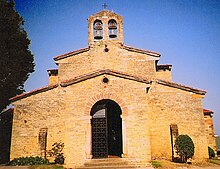San Julián de los Prados
| Church of San Julián de los Prados | |
|---|---|

Facade of the church of San Julián de los Prados
|
|
| Basic information | |
| Location |
|
| Geographic coordinates | 43°22′3.7″N 5°50′14.1″W / 43.367694°N 5.837250°WCoordinates: 43°22′3.7″N 5°50′14.1″W / 43.367694°N 5.837250°W |
| Affiliation | Roman Catholic |
| Province | Asturias |
| Country | Spain |
| Year consecrated | 9th century |
| Ecclesiastical or organizational status | Church |
| Heritage designation | World Heritage Site |
| Architectural description | |
| Architect(s) | Tioda |
| Architectural type | Church |
| Architectural style | Pre-Romanesque |
| Specifications | |
| Direction of façade | SE |
| Length | 30 metres (98 ft) |
| Width | 25 metres (82 ft) |
| Type | Cultural |
| Criteria | ii, iv, vi |
| Designated | 1985 (9th session) |
| Parent listing | Monuments of Oviedo and the Kingdom of the Asturias |
| Reference no. | 312 |
| Extensions | 1998 |
| State Party | Spain |
| Region | Europe and North America |
San Julián de los Prados, also known as Santullano, is a Pre-Ramirense church from the beginning of the 9th century in Oviedo, the capital city of the Principality of Asturias, Spain. It is one of the greatest works of Asturian art and was declared an Historical-Artistic Monument by the Spanish Ministry of Culture in June 1917 and a World Heritage Site by UNESCO on 2 December 1998.
The church's construction was ordered by Alfonso II of Asturias and it was built by the court architect Tioda c. 830. It is dedicated to the martyred Egyptian saints Julian and Basilissa.
The spacious church clearly displays the characteristics of its style. It is of basilican plan with a nave and two aisles separated by square piers which support semi-circular arches and with a transept of impressive height. The iconostasis, that separates the sanctuary from the rest of the church is remarkably similar in appearance to a triumphal arch. The size and originality of the church stands out and distinguishes it from works of Visigothic art. However, without doubt, that which most attracts attention to this church is the pictorial decoration, with aniconic frescoes (stucco, very well executed), painted in three layers, with architectural decoration that bears clear Roman influences. Although it appears more a monastic rather than a royal church, a gallery was reserved for the king in the transept.
Of the three original entrances to the church, two have been filled in.
...
Wikipedia
